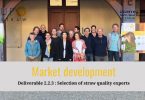This paper explores the decisions made during the design and construction of an award-winning Low Carbon House, and how these relate to ongoing in-situ monitoring of this home. Analysis of the design process uses the IDEF-0 modelling method, with the objective of investigating the factors that influence design decisions. The building is currently intensively monitored for thermal and moisture aspects. The house studied has been designed by the client/occupant. Important aspects considered within the design process were embodied energy and heating energy demands, which led to the use of local timber, straw bale, loose sheep’s wool, lime renders and clay paints for the walls
Authors:
- Carfrae, Jim
- Goodhew, Steve







